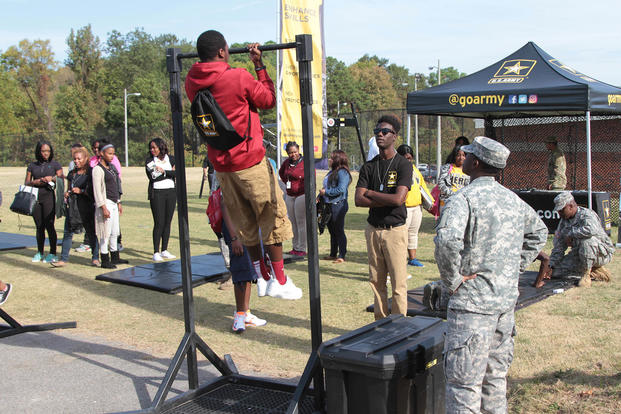The U.S. Army has launched a pilot program to bring all three components -- active, Guard and Reserve -- under one recruiting mission as leaders wrestle with the challenges of adding more soldiers to the force.
Last December, the fiscal 2017 National Defense Authorization Act (NDAA) halted the Army's planned drawdown to 450,000 and ordered the active force to grow to 476,000.
The move increased the active-duty recruiting mission for U.S. Army Recruiting Command from 62,500 to 68,500, a significant challenge for recruiters who normally start their mission Oct. 1, the beginning of the fiscal year, according to Maj. Gen. Jeffrey Snow, commander of Army Recruiting Command.
"It's a tough mission, and getting that mission one quarter into [fiscal 2017] -- that was the largest in-the-year-of-execution mission increase we have had since we have been an all-volunteer force," Snow told Military.com at the 2017 Association of the United States Army's annual meeting.
Related content:
- Army Rolls Out Field Manual Focused on Fighting Near-Peer Adversaries
- Army Chief: Modernization Reform Means New Tanks, Aircraft, Weapons
- Next Army Combat Vehicle May Feature Active Protection, Laser Weapons
Despite the hurdle, Snow's command exceeded its fiscal 2017 active goal by more than 300 soldiers.
The Reserve component's recruiting goal did not go as well, he admits.
Recruiting Command fell short of its fiscal 2017 Reserve recruiting goal of 14,400 soldiers by 1,228 soldiers, Snow said, explaining that some of those soldiers may have gone to the National Guard, which recruits separately from the Army active and Reserve components.
Now a new pilot program, launched in June, will study the possibility of bring the Army's active, Reserve and National Guard under one recruiting umbrella, he said.
"The Army has obviously got three components; we only recruit for two of those in this command," Snow said. "United States Army Recruiting Command has responsibility for two components -- that's Reserve and Active."
The National Guard falls under the adjutant generals, who work for state governors, he said.
"It's a challenge because, right now in many parts of the country, the states put their National Guard ahead of the regular Army and Army Reserve," Snow said.
Recruiting as one Army would mean "we leverage recruiters to recruit for all three components, which I have always felt this is the right thing to do," he said.
"It's a multi-year pilot ... because there are some things we are going to have to work through," Snow said.
Right now, in 40 out of 50 states, it is actually more advantageous for a young person to join the National Guard than it is to join the Army Reserve, according to Snow.
"What the states do, particularly if [potential recruits] have the desire to pursue post-secondary education, the states add state benefits, predominantly in the form of educational benefits, on top of the federal benefits," he said.
Recruiting as one Army may be beneficial to the National Guard as well because there are some parts of the country where the Guard struggles to make its mission, Snow said.
For now, he is focused on his fiscal 2018 mission, which features a Reserve recruiting mission increase from 14,400 to 15,600 soldiers.
But the real challenge, Snow said, is the proposed increase in the active mission -- from 68,500 to 80,000 soldiers -- which could change once the fiscal 2018 NDAA is finalized.
"We don't know what the appropriations are going to be," he said. "Whatever our political leaders decide, if we have to reduce the mission, it's easier to take a mission decrease than a mission increase."
-- Matthew Cox can be reached at matthew.cox@military.com.




























